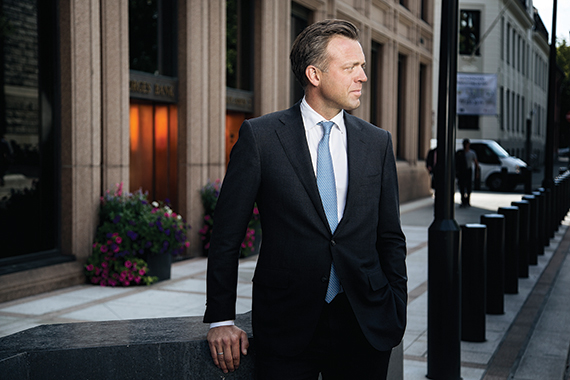It may be the world’s biggest sovereign wealth fund but low oil prices have led Norway’s government to dip into its reserves and now all eyes are on the fund’s property arm. David Hatcher met chief executive Karsten Kallevig

The headquarters of Norway’s central bank and $830bn oil fund is understated. Discreet despite its enormous scale – not unlike the Oslo-based investor itself.
Once through the high-security entrance – which includes single-person pod doors opened with your own personal pin code and, once upon a time, weight plates to ensure no one has snaffled any gold on the way out – the office of Karsten Kallevig strikes a similarly modest tone. The chief executive of Norges Bank Real Estate Management’s surroundings are immaculately tidy and without the slightest hint of personalisation.
 Such focus is perhaps not particularly surprising given that he is in charge of the fund’s $20.3bn of direct property – an all-consuming role. One that is, in his own words, about “creating a legacy for the Norwegian people”.
Such focus is perhaps not particularly surprising given that he is in charge of the fund’s $20.3bn of direct property – an all-consuming role. One that is, in his own words, about “creating a legacy for the Norwegian people”.
Now is an interesting time for Norges. The oil price has halved to $48 per barrel over the past two years and at the start of the year the Norwegian government withdrew cash from the fund – albeit a modest $819m – for the first time in its history, to cover expenses.
With bond rates at all-time lows and equities unpredictable, the need for its real estate division to deliver the relatively high returns the sector aims to offer is more pressing than ever. That, Kallevig says, means working less with joint venture partners, recruiting more staff in local offices, and breaking Asia.
Here, the 43-year-old reveals what is next for Norges as it looks to expand its portfolio around the world and explains why the Brexit vote will not deter him from investing more in the UK.
Oil revenues
The Norwegian Government Pension Fund was established in 1990 to invest the surplus wealth produced by the country’s petroleum income to counter fluctuating oil prices and the ultimate prospect of resources running dry. It began investing in real estate through Norges in 2010 with its global debut on Regent Street in London, with The Crown Estate. The UK has been the apple of Norges’ eye ever since as far as Europe is concerned and the fund has more than twice as much property in the country than anywhere else in the region (see Norges in Numbers, right).
The oil fund’s revenues are estimated to peak in around 2030 but in the interim it will need to address those fluctuations – the current oil price plummet being a case in point. Luckily Kallevig is ready to step into the breach with a strategy to allow the bank and oil fund to obtain higher yields through the real estate arm. It is a plan that will see Norges go it alone on more deals in the future, reining back on the joint venture agreements it has been traditionally known for.
Before analysing exactly what this fresh strategy might look like in reality, it is worth looking in more detail at the facts and figures behind one of the biggest, most ambitious real estate investors in the world.
Sustainable expansion
The direct real estate division invests roughly 0.5% to 0.67% of the total size of the fund each year, equivalent to $4.2bn to $5.6bn at its current size. It is, in essence, a forced buyer, but Kallevig politely insists that this rate of expansion is sustainable.
“Obviously the fund has become bigger over time but investing 0.5% per year doesn’t sound crazy,” says Kallevig confidently. “It’s not necessarily a goal in and of itself but a pacesetter. I think that is very feasible and that will mean that in four or five years we will expect to hit around 5% of the fund.”
The fund as a whole has a 4% real return target, in line with the annual cap the government is allowed to withdraw from the fund, but returned only 2.7% in 2015. Last year, direct real estate provided a 10.8% return, marginally above the IPD global index Kallevig is mandated with achieving.
Its property portfolio, including $5.4bn of property shares, makes up only 3.1% of the fund but in April the finance ministry announced it was considering upping its allocation from 5% to 7% – strategic targets that it is anticipated will be hit in the medium term.
Crudely, were the fund to stay the same size, this means $17bn must be invested in property to take the sector to 5% of the fund and the same again to reach 7%, albeit this is likely to be a strict upper limit. The division started with a staff of three but by the end of last year employed 122 and Kallevig is aiming to grow this to 200.
The need to expand the real estate portfolio of the fund so enormously means that Norges is a rare seller.
“If you are reliant on flipping assets, it is very expensive with advisory costs and taxes, and if you are doing high return deals then maybe it is OK but for us, it isn’t practical,” says Kallevig. “That means we have to pick some markets we can be in for a really long time and get to understand them well.”
Norges’ real estate division does not invest domestically because the fund is designed to diversify its exposure away from its own oil-linked economy and has commonly joint ventured with partners when accessing new markets and allowed them to front up the operation. With its ever-growing staff, experience and allocation, Kallevig is now gearing up to make big bets that will see Norges become a more prominent and independent investor.
It initially opted for joint ventures for its property investment push as it started with a team of just three and “because we were so large that we would have to either be with literally hundreds of GPs [general partners] or we would be so big with each GP that we might as well be the GP”.
“There are two things that are key with joint ventures for us. One is operating capability, because ultimately we don’t really need the joint venture partner for their money. We want them because they can operate, have a presence in the market and know all about the deals flows – that’s a great plus.
“We also want them to be able to invest alongside us. Skin in the game really needs to be on an equal level. If you have 95:5, the 5% might be big for them but it creates a different dynamic in the room than 50:50 or 60:40. If it’s ‘you put up a billion, I put up a billion, now let’s figure out how we deal with it,’ it just makes it a different type of partnership.”
Full control
But Norges is running out of suitable like-minded partners and its desire to take full control of deals is growing in line with its in-house expertise and need to expand its portfolio.
“We’d love to do more but from a cost point of view, from a control point of view and quite frankly a deal point of view, it’s attractive not to have a partner sometimes,” says Kallevig. “Sometimes you come across something and think all of this would be good for the fund. Sometimes there are no partners that want any of it, so do we not do the deal or do it by ourselves? It doesn’t mean we will cut joint ventures but it means we will probably have a broader spectrum of things we own by ourselves and asset manage ourselves with some help.”
In London, this includes Bank of America’s 2 King Edward Street office in EC1, which Norges bought from GIC in 2014 for £582.5m and the West One shopping centre above Bond Street underground station, which it bought from Orchard Street last year for £245m.
In terms of which geographies Norges will be focusing on, the UK remains on the hit list based on a strong, existing relationship. As well as its debut property deal on Regent Street, its prized assets include 57.75% of Pollen Estate and a 50% stake in British Land’s Meadowhall shopping centre in Sheffield.
Kallevig is adamant that the Brexit vote, despite bringing increased uncertainty, has not deterred him from investment into the UK – Norges’ July purchase of 355-361 Oxford Street, W1 in July for £124m from Aberdeen Asset Management was made after the referendum and from a seller forced to do so as a result of the vote.
“Article 50 hasn’t been triggered yet. We don’t know when it will be, we don’t know when the exit will happen, on what terms it will happen, what has been priced in, what investors will think, and quite frankly what London or the UK will do in response to whatever the terms of Brexit are. So, forecasting the future I think is very difficult, but in itself, based on where we are now, it is not changing our view of London as one of the most important cities in Europe,” he says.
The Oxford Street buy was one at the very bottom of its typical range and more of an example of an opportunistic situation. More typical are deals such as its 25% stake in Regent Street, W1, from the Crown Estate for £448m in 2010 and its joint venture with Prologis, which was formed in 2012 with an initial €2.4bn portfolio.
“Small deals take time and there is also huge competition,” says Kallevig. “If you look at a £30m deal in Mayfair, you’re not in competition with four or five – it’s hundreds and they all have different motivations, driving pricing. The fact is on the largest transactions, you only have between two and five serious buyers.”
Beyond London, Norges is focused on nine other cities – Paris, Munich, New York, Washington DC, Boston, San Francisco, Tokyo and Singapore, the last two of which it has yet to make its first investment in. Within each one is an individual, geographical and sector-oriented strategy.
“Each of these cities has scale, good prospects for population growth, employment growth and most of them pretty decent supply constraints,” says Kallevig. “We have been very disciplined, doing things step-by-step and I think at the very beginning we probably thought we would spread ourselves more than we’ve ended up doing. To be good in real estate you really have to understand all of the [local] market dynamics, tenant dynamics and capital flows. Experience has shown that there’s actually quite a lot you can do in each city.”
It makes perfect sense. The largest sovereign wealth fund in the world taking more control of its portfolio. All done in a typically Norwegian fashion of course. Discreet, modest and understated.
Norge in numbers
Norges’ UK direct property holdings
Asset
- Meadowhall, Sheffield (50%)
- 2 King Edward Street, EC1
- Queensberry House, W1
- West One Shopping Centre, W1
- Pollen Estate (57.75%)
- Prologis Europe Partnership (50%)
- The Crown Estate Partnership/”Regent Street” (25%)
- *355-361 Oxford Street, W1
*not included in overall figures
Norges’ European direct real estate portfolio – 31.12.2015 |
|
|---|---|
| 366 assets $10.3bn | |
| Year | $bn |
| 2011 | 2 |
| 2012 | 4 |
| 2013 | 7 |
| 2014 | 9 |
| 2015 | 10 |
By geography |
$bn |
% |
|---|---|---|
| UK | 5.4 | 52.4% |
| France | 2.2 | 21.4% |
| Germany | 0.7 | 6.8% |
| Other | 2 | 19.4% |
| Total | 10.3 |
Norges’ global direct real estate portfolio – 31.12.2015 |
|
|---|---|
| 797 assets | |
| $bn | |
| Europe | 10.3 |
| US | 10 |











